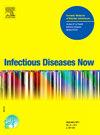Evaluating the impact of artificial intelligence in antimicrobial stewardship: a comparative meta-analysis with traditional risk scoring systems
IF 2.2
4区 医学
Q2 INFECTIOUS DISEASES
引用次数: 0
Abstract
Objectives
The growing challenge of antimicrobial resistance (AMR) has underscored the urgent need for robust antimicrobial stewardship programs (AMS). Artificial intelligence (AI) and machine learning (ML) have emerged as promising tools to support enhanced decision-making in AMS. This systematic review and meta-analysis aims to evaluate the impact of AI in AMS and compare its effectiveness with traditional risk systems.
Methods
PubMed/MEDLINE, Scopus, EMBASE, and Web of Science were searched to identify studies published up to July 2024. Any studies that evaluated the use of AI/ML in AMS compared with conventional decision-making approaches were eligible. Outcomes of interested were predictive performance metrics and diagnostic accuracy. The meta-estimate was performed pooling standardized mean difference, and effect size (ES) measured as Cohen’s d with a 95% confidence interval (CI). The risk of bias was assessed using the QUADAS-AI tool.
Results
Out of 3,458 studies, 27 were included, demonstrating that ML models outperform traditional methods in terms of sensitivity [1.93 (0.48–3.39) p = 0.009], and negative predictive value [1.66 (0.86–2.46), p < 0.001] but not in terms of area under the curve, accuracy, specificity, positive predictive value, when random effect models were applied.
Conclusions
Our results revealed that ML tools offer promising enhancements to traditional AMS strategies. However, high heterogeneity, inconsistent results between fixed and random effect models, and limited use of external validation in retrieved studies raise concerns about the generalizability of the findings. Furthermore, the lack of representation from outpatient and pediatric settings highlights a critical equity gap in the application of these technologies.
评估人工智能对抗菌药物管理的影响:与传统风险评分系统的比较荟萃分析
目的抗菌素耐药性(AMR)的挑战日益严峻,迫切需要强有力的抗菌素管理计划(AMS)。人工智能(AI)和机器学习(ML)已成为支持增强AMS决策的有前途的工具。本系统综述和荟萃分析旨在评估人工智能在AMS中的影响,并将其与传统风险系统的有效性进行比较。方法检索spubmed /MEDLINE、Scopus、EMBASE和Web of Science,检索截止到2024年7月发表的研究。任何评估AI/ML与传统决策方法在AMS中的使用的研究都是合格的。结果感兴趣的是预测性能指标和诊断准确性。meta估计采用合并标准化均差进行,效应大小(ES)采用Cohen’s d测量,置信区间为95%。使用QUADAS-AI工具评估偏倚风险。结果在3458项研究中,有27项被纳入,表明ML模型在敏感性[1.93 (0.48-3.39)p = 0.009]和阴性预测值[1.66 (0.86-2.46),p <;0.001]但在应用随机效应模型时,曲线下面积、准确性、特异性、阳性预测值等方面均无显著差异。结论研究结果表明,ML工具对传统的AMS策略有很好的增强作用。然而,高异质性,固定和随机效应模型之间的结果不一致,以及在检索研究中有限使用外部验证,引起了对研究结果可推广性的关注。此外,缺乏来自门诊和儿科设置的代表突出了在这些技术的应用一个关键的公平差距。
本文章由计算机程序翻译,如有差异,请以英文原文为准。
求助全文
约1分钟内获得全文
求助全文
来源期刊

Infectious diseases now
Medicine-Infectious Diseases
CiteScore
7.10
自引率
2.90%
发文量
116
审稿时长
40 days
 求助内容:
求助内容: 应助结果提醒方式:
应助结果提醒方式:


